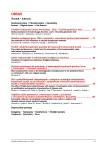Global assessment of haemostagic function - part I. Thrombin generation test
Authors:
A. Hluší; L. Slavík; J. Úlehlová; V. Krčová; K. Indrák
Authors‘ workplace:
Hemato-onkologická klinika FN a LF UP Olomouc
Published in:
Transfuze Hematol. dnes,16, 2010, No. 2, p. 65-70.
Category:
Comprehensive Reports, Original Papers, Case Reports
Overview
There are numerous assays available for evaluation of the hemostatic system in humans, including clotting times of different types, investigation of single components of clotting system such as factors, inhibitors, specific mutations, lupus anticoagulant, bleeding time and platelet aggregation. These tests do not cover complexity of clotting system. The central enzyme of the hemostatic system is thrombin. Estimation of an individualęs potential to generate thrombin may closely correlate with hyper- or hypo-coagulable state. Thrombin generation assays have been studied in various settings including acquired and congenital bleeding and thrombophilic states or in platelet disorders. Several variations of the assay do exist depending on the investigated defect. There are still considerable inter-laboratory variations which make the comparison between studies difficult.
Key words:
thrombin, thrombophilia, thrombin generation test
Labels
Haematology Internal medicine Clinical oncologyArticle was published in
Transfusion and Haematology Today

2010 Issue 2
Most read in this issue
- Treatment of relapsed and refractory Hodgkin lymphoma
- Global assessment of haemostagic function - part I. Thrombin generation test
- The detection of TP53 mutations in chronic lymphocytic leukemia
- Short morphometric notes to the heterogeneity of lymphocytes in the peripheral blood („a minireview“ with own original results)
